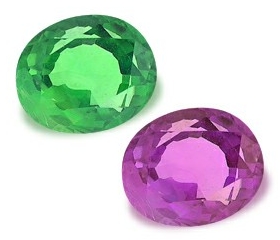 Alexandrite– Another of June’s birthstones is the Alexandrite. The stone is named after Prince Alexander of Russia (which is why the “A” in Alexandrite is capitalized), who was to later become Czar Alexander II in 1855). Discovered in 1839 on the day of the prince’s birthday, Alexandrite was found in an emerald mine in the Ural Mountains of Russia. Because it is a relatively recent discovery, there has been little time for myth and superstition to build around this unusual stone. In Russia, the stone was also popular because it reflected the Russian national colors, green and red, and was believed to bring good luck. The Alexandrite possesses an enchanting chameleon-like personality. In daylight, it appears as a beautiful green, sometimes with a bluish cast or with a brownish tint. However, under artificial lighting, the stone turns reddish-violet or violet. Alexandrite belongs to the chrysoberyl family, a mineral called beryllium aluminum oxide in chemistry jargon, that contains the elements beryllium, aluminum and oxygen. This is a hard mineral, only surpassed in hardness by diamonds and corundum (sapphires and rubies). The unusual colors in Alexandrite are attributed to the presence of chromium in the mineral. Chrysoberyl is found to crystallize in pegmatites (very coarse-grained igneous rock, crystallized from magma) rich in beryllium. They are also found in alluvial deposits, weathered pegmatites containing the gemstones that are carried by rivers and streams. Alexandrite is an uncommon stone, and therefore very expensive. Sri Lanka is the main source of Alexandrite today, and the stones have also been found in Brazil, Malagasy, Zimbabwe, Tanzania and Burma. Synthetic Alexandrite, resembling a reddish-hued amethyst with a tinge of green, has been manufactured but the color change seen from natural to artificial lighting cannot be reproduced. Such stones have met with only marginal market success in the United States. Back to Top
Alexandrite– Another of June’s birthstones is the Alexandrite. The stone is named after Prince Alexander of Russia (which is why the “A” in Alexandrite is capitalized), who was to later become Czar Alexander II in 1855). Discovered in 1839 on the day of the prince’s birthday, Alexandrite was found in an emerald mine in the Ural Mountains of Russia. Because it is a relatively recent discovery, there has been little time for myth and superstition to build around this unusual stone. In Russia, the stone was also popular because it reflected the Russian national colors, green and red, and was believed to bring good luck. The Alexandrite possesses an enchanting chameleon-like personality. In daylight, it appears as a beautiful green, sometimes with a bluish cast or with a brownish tint. However, under artificial lighting, the stone turns reddish-violet or violet. Alexandrite belongs to the chrysoberyl family, a mineral called beryllium aluminum oxide in chemistry jargon, that contains the elements beryllium, aluminum and oxygen. This is a hard mineral, only surpassed in hardness by diamonds and corundum (sapphires and rubies). The unusual colors in Alexandrite are attributed to the presence of chromium in the mineral. Chrysoberyl is found to crystallize in pegmatites (very coarse-grained igneous rock, crystallized from magma) rich in beryllium. They are also found in alluvial deposits, weathered pegmatites containing the gemstones that are carried by rivers and streams. Alexandrite is an uncommon stone, and therefore very expensive. Sri Lanka is the main source of Alexandrite today, and the stones have also been found in Brazil, Malagasy, Zimbabwe, Tanzania and Burma. Synthetic Alexandrite, resembling a reddish-hued amethyst with a tinge of green, has been manufactured but the color change seen from natural to artificial lighting cannot be reproduced. Such stones have met with only marginal market success in the United States. Back to Top
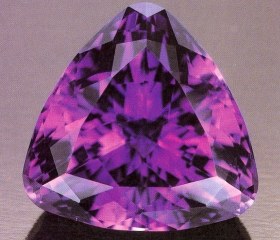
Amethyst – The Ancient Greeks believed that whomever wore this gemstone would be protected from the intoxicating effects of wine and the name is derived from the Greek word “amethustos” meaning, “not drunk”. Amethyst, the birthstone for February, is a variety of quartz and occurs in transparent light to dark purple. It has long been treasured by kings, queens and religious figures, dating back to the Minoan period (c. 2500 B.C.), because of its rich, royal color. Amethyst was a favorite of the Art Nouveau craftsmen of the 1920’s and is still a favorite of some of the most creative jewelry designers of today. The most notable reason for their popularity in jewelry design has been the wide availability and reasonable price. The two main sources of amethyst are Brazil and Zambia, although other deposits have been found in Russia, Sri-Lanka, Mexico, and Arizona.
Enhancements – The scarcity of fine amethyst in recent years has prompted the production of a manmade synthetic making its way into the market. Darker hues of amethyst are rarely enhanced to perfect their color, although some varieties do respond well to heat treatment. Brownish varieties, when heated, magically turn into the bright yellow or orange colors known as citrine. This enhancement method is permanent and will last the lifetime of the gemstone. Back to Top
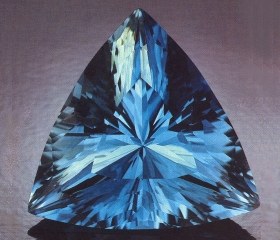
Aquamarine – Latin for seawater, this beautiful gemstone inspires visions of the transparent azure blue waters of the Caribbean. Aquamarine is identifiable by its flawless crystallization and greenish-blue color, just like the Caribbean water that is so clear that you can see through the surface to the sand below. As the birthstone for March, aquamarine differs greatly from its most famous relative, emerald. Both are from the gemstone group known as beryl. However, while emeralds are almost always imperfect (having visible inclusions) aquamarines are almost always flawless (no visible inclusions under 10x power magnification). Aquamarine has been credited with providing courage, curing laziness and quickening the intellect. Among some cultures, it had the reputation for providing happiness and everlasting youth. Brazil is the most prolific supplier of aquamarine today, with the natural color from this area leaning towards bluish-green. Other sources of aquamarine include Tanzania, Kenya, Nigeria, Afghanistan, Russia, and the island of Sri Lanka.
Enhancements – Aquamarines that you see today are almost always enhanced by controlled heating. Natural occurring bluish-green gemstones are heated in this manner to remove the green, leaving a more pleasing blue hue. The treatment has become a very common and very acceptable enhancement technique for aquamarine gemstones, and is one that is permanent for the life of the gemstone. Back to Top
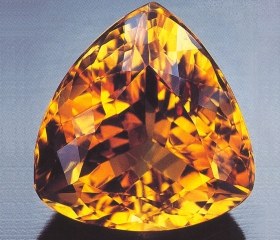 Citrine – Citrine is the lovely yellowish gem belonging to the quartz species of gemstones. Its name is derived from its lemon-yellow color and the French word “citron”, meaning lemon. Most commercial citrines are heat-treated amethysts or smoky quartzes. Citrine is available in colors ranging from pastel yellows to wonderful orange hues, with the finest quality citrine being medium to dark in tone, vivid in intensity, and yellowish-orange in color. It is plentiful in nature and found principally in Brazil, Bolivia and Spain. The warm hues are reminiscent of the sun, health and vitality, and represent an incredible value for those who appreciate its colors. Actually, because of its beauty and lower price, citrine is commonly used a replacement for topaz as the birthstone for November.
Citrine – Citrine is the lovely yellowish gem belonging to the quartz species of gemstones. Its name is derived from its lemon-yellow color and the French word “citron”, meaning lemon. Most commercial citrines are heat-treated amethysts or smoky quartzes. Citrine is available in colors ranging from pastel yellows to wonderful orange hues, with the finest quality citrine being medium to dark in tone, vivid in intensity, and yellowish-orange in color. It is plentiful in nature and found principally in Brazil, Bolivia and Spain. The warm hues are reminiscent of the sun, health and vitality, and represent an incredible value for those who appreciate its colors. Actually, because of its beauty and lower price, citrine is commonly used a replacement for topaz as the birthstone for November.
Enhancements – Citrine is routinely subjected to heat as a normal part of the processing phase to improve color. This treatment is very common, it is undetectable and is very stable. Back to Top
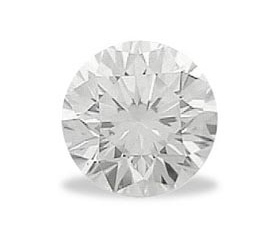 Diamond – April’s birthstone is the diamond. Diamonds are a wonder of nature. Their cold sparkling fire has held us spell-bound for centuries, inspiring rich passionate myths of romance, intrigue, power, greed, and magic. Ancient Hindus, finding diamonds washed out of the ground after thunderstorms, believed they were created by bolts of lightning. In our place and time, the diamond is a symbol of enduring love, and often grace engagement rings. There are many kinds of diamonds: transparent, translucent or opaque; ranging from colorless to sooty black, with many colors in between. Mostly transparent diamonds, colorless or tinted, are used as jewelry. Others are used widely in industry. The color of a diamond depends on the kind of impurities embedded inside it. Yellow diamonds, for example, betray minute quantities of nitrogen, while boron imparts a bluish hue. There are other inclusions in diamonds that have great scientific value. Such samples are time capsules that yield valuable information about conditions deep in the Earth’s upper mantle where diamonds formed, and yield clues to the formation and age of the diamond. Diamonds are the rich cousins of graphite, both crystalline forms of pure carbon. The enormous differences in their properties is a result of the way that carbon atoms are bonded together. In graphite, carbon atoms are arranged in sheets that easily slide past each other, making them ideal as lubricants and of course, pencil leads. Diamond crystals, on the other hand, are a tight-fisted network of carbon atoms securely held in four directions, making it the hardest naturally-occuring substance in the world. In order to achieve such a compact and strongly-held network of carbon atoms, it is believed that diamonds must have crystallized deep under the Earth’s surface. At these depths exist the proper conditions for the formation of diamonds; at 90 to 120 miles deep, pressures are more than 65,000 times that of the atmosphere at the Earth’s surface, with temperatures exceeding 2,700 degrees Fahrenheit. Such pressures and temperatures reproduced in laboratories have successfully yielded synthetic diamonds. Diamonds are found in alluvial deposits, that is, gravel swept by streams, rivers, glaciers and ocean currents. They are also found in sedimentary rock where gravel deposits and organic material have been compressed into rock. Diamonds can be found in some samples of kimberlite — a type of volcanic rock first identified in Kimberly, South Africa. Diamonds found in kimberlite are thought to be very old, perhaps as much as three billion years old. Tiny flecks of diamond have even been found inside meteorites — bits of rocky space debris that land on Earth. Diamonds are crystals, crystals being the ultimate form of symmetry in nature. The shape of the crystal reflects the internal orderly arrangement of atoms within it. In diamonds, atoms of carbon are held tightly by covalent bonding, where two neighboring atoms share an electron, endowing the diamond crystal with great strength. But despite its hardness, diamonds can be cut. This is accomplished by cutting the gem along planes parallel to the faces of the crystal where the tight bonds between carbon atoms are a little weaker. Found in their natural form, diamonds can appear quite unimpressive. It is only when they are cut and polished by skilled craftsmen, such that the light entering it is reflected and refracted as best possible, only then is their hidden beauty revealed. Back to Top
Diamond – April’s birthstone is the diamond. Diamonds are a wonder of nature. Their cold sparkling fire has held us spell-bound for centuries, inspiring rich passionate myths of romance, intrigue, power, greed, and magic. Ancient Hindus, finding diamonds washed out of the ground after thunderstorms, believed they were created by bolts of lightning. In our place and time, the diamond is a symbol of enduring love, and often grace engagement rings. There are many kinds of diamonds: transparent, translucent or opaque; ranging from colorless to sooty black, with many colors in between. Mostly transparent diamonds, colorless or tinted, are used as jewelry. Others are used widely in industry. The color of a diamond depends on the kind of impurities embedded inside it. Yellow diamonds, for example, betray minute quantities of nitrogen, while boron imparts a bluish hue. There are other inclusions in diamonds that have great scientific value. Such samples are time capsules that yield valuable information about conditions deep in the Earth’s upper mantle where diamonds formed, and yield clues to the formation and age of the diamond. Diamonds are the rich cousins of graphite, both crystalline forms of pure carbon. The enormous differences in their properties is a result of the way that carbon atoms are bonded together. In graphite, carbon atoms are arranged in sheets that easily slide past each other, making them ideal as lubricants and of course, pencil leads. Diamond crystals, on the other hand, are a tight-fisted network of carbon atoms securely held in four directions, making it the hardest naturally-occuring substance in the world. In order to achieve such a compact and strongly-held network of carbon atoms, it is believed that diamonds must have crystallized deep under the Earth’s surface. At these depths exist the proper conditions for the formation of diamonds; at 90 to 120 miles deep, pressures are more than 65,000 times that of the atmosphere at the Earth’s surface, with temperatures exceeding 2,700 degrees Fahrenheit. Such pressures and temperatures reproduced in laboratories have successfully yielded synthetic diamonds. Diamonds are found in alluvial deposits, that is, gravel swept by streams, rivers, glaciers and ocean currents. They are also found in sedimentary rock where gravel deposits and organic material have been compressed into rock. Diamonds can be found in some samples of kimberlite — a type of volcanic rock first identified in Kimberly, South Africa. Diamonds found in kimberlite are thought to be very old, perhaps as much as three billion years old. Tiny flecks of diamond have even been found inside meteorites — bits of rocky space debris that land on Earth. Diamonds are crystals, crystals being the ultimate form of symmetry in nature. The shape of the crystal reflects the internal orderly arrangement of atoms within it. In diamonds, atoms of carbon are held tightly by covalent bonding, where two neighboring atoms share an electron, endowing the diamond crystal with great strength. But despite its hardness, diamonds can be cut. This is accomplished by cutting the gem along planes parallel to the faces of the crystal where the tight bonds between carbon atoms are a little weaker. Found in their natural form, diamonds can appear quite unimpressive. It is only when they are cut and polished by skilled craftsmen, such that the light entering it is reflected and refracted as best possible, only then is their hidden beauty revealed. Back to Top
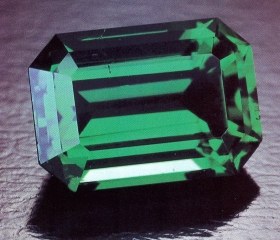 Emerald– The name emerald is derived from the Greek word Smaragdos meaning “green stone” and, in ancient times, it referred to just about any green colored gemstone. The birthstone for May, emerald is the most prized and precious variety of the gemstone group known as beryl, which also consists of aquamarine and other variations of beryl. Today, most of the world’s Emeralds are mined in Columbia, Brazil and Zambia. The green color of emerald is incomparable in the world of gemstones and, for this reason, the color is commonly referred to as “emerald green”. The green color in emerald is caused by the presence of chromium in the chemical composition of this particular form of beryl. Under magnification the internal characteristics in an emerald, which include liquid bubbles, gas bubbles, internal stress fractures, and foreign crystals form a virtual garden within the gemstone. Most natural Emeralds contain a variety of these internal inclusions, commonly referred to as “jarden”, which is French for garden. Perfection in emerald, as in most all things, is the most rare of nature’s treasures. Emerald is the birthstone for May and symbolizes rebirth and youth.
Emerald– The name emerald is derived from the Greek word Smaragdos meaning “green stone” and, in ancient times, it referred to just about any green colored gemstone. The birthstone for May, emerald is the most prized and precious variety of the gemstone group known as beryl, which also consists of aquamarine and other variations of beryl. Today, most of the world’s Emeralds are mined in Columbia, Brazil and Zambia. The green color of emerald is incomparable in the world of gemstones and, for this reason, the color is commonly referred to as “emerald green”. The green color in emerald is caused by the presence of chromium in the chemical composition of this particular form of beryl. Under magnification the internal characteristics in an emerald, which include liquid bubbles, gas bubbles, internal stress fractures, and foreign crystals form a virtual garden within the gemstone. Most natural Emeralds contain a variety of these internal inclusions, commonly referred to as “jarden”, which is French for garden. Perfection in emerald, as in most all things, is the most rare of nature’s treasures. Emerald is the birthstone for May and symbolizes rebirth and youth.
Enhancements – When mined from the earth, almost all Emeralds have internal inclusions, or “birthmarks”, some of which distinguish them as natural gemstones. Since early times, merchants would purify the color of Emeralds by immersing them in oils or paraffin, which would fill the fissures that were open at the surface and render them almost invisible to the naked eye. Along with the use of oils and resins, there are much more sophisticated techniques being used today to clarity enhance Emeralds. Back to Top
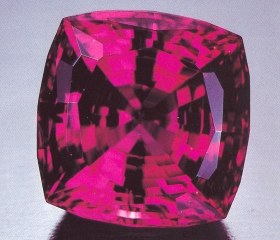
Garnet ~ January’s Birthstone– Garnet is a group of gemstones that occurs in a virtual rainbow of colors. The name garnet is derived from the Latin word for grain, because of the round shape of the crystals, as well as the Greek word “granatum” for the pomegranate seed. The most common garnets are the reddish varieties, which bear the names Almandite, Pyrope, and Rhodolite. These gemstones occur in a range of colors from medium to dark reddish orange (Almandite and Pyrope) to purplish red to reddish purple (Rhodolite). Garnet is the traditional birthstone for the month of January, however, red need not be your color of choice if you were born in the first month of the year. Other more interesting gems from the garnet family, being used in jewelry today, consist of pinkish orange tones (Malaia) to those that exhibit a variety of colors that have the ability to change tones, depending on the light source, and are known as color change garnets. Lesser known garnets occur in a yellowish orange (Spessartite) to the more rare varieties that occur in green tones (Tsavorite and Demantoid).
Enhancements – All varieties of garnet are completely natural in color and clarity. There are no known commercial treatments being done today to enhance these beautiful gemstones. The owner of any one of garnet’s beautiful colors will cherish the fact that their garnet is one of the few colored gemstones in today’s market that exhibits the exact color and clarity that mother nature produced, with it’s beauty brought to the surface strictly by the artistry of the cutter. Back to Top
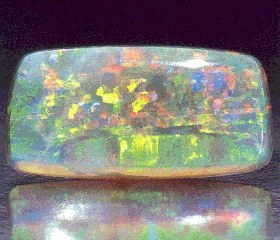
Opal
– The name opal is derived from an Indian word for “stone” and they are divided into three basic groups with physical properties that vary considerably:
- Precious opal – The special characteristic of these gems is their opalescence, more appropriately referred to as “play-of-color”. The more predominant types within this group are white opals that are translucent to semitransparent with play-of-color against a white bodycolor, black opals that are translucent to opaque with play-of-color against a black or other dark bodycolor, jelly opals that are colorless, transparent to semitransparent with little or no play-of-color, and boulder opals which are opaque and made up of a thin layer of opal occurring in ironstone matrix; the opal is cut and polished for the top and the matrix stone is left as a backing that adds strength and a dark background. Opal always contains water in variable amounts, but it can be as much as 30%. If not cared for properly, opals can lose water over time causing crazing, or cracking. White opals will be the most common found in jewelry and the value of an opal gemstone will be more determined by its play-of-color than by size.
- Fire opal – These opals are some of the most interesting since they do not look like what the average consumer would identify as an opal. They are transparent to semitransparent with or without play-of-color on a yellow, red or orange bodycolor. The most important deposits of fire opal are in Mexico and, for that reason, these beautiful gemstones are often called “Mexican Opals”.
- Common opal – Very common, as the name would imply, and mostly opaque without play-of-color.
Opals, an optional birthstone for the month of October, are relatively soft gemstones and do not react well to heat or sudden changes in temperature. Opals are prized by many for their phenomenal play of color, and while they do make beautiful pieces of jewelry to be worn and appreciated, extreme care must be taken to protect these gems from damage. Because of their moisture content they require special care even when they are not being worn. When purchasing opal jewelry it is important to discuss their proper care with a gemologist, to insure that their beauty will be maintained and passed on from generation to generation. Back to Top
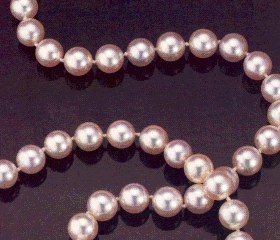
Pearl – The pearl is unique in the world of gemstones, as it is the only gemstone that is formed within a living creature. Known as the birthstone for the month of June, pearls are truly a treasured gift of the sea and revered for their colors, shapes, sizes and luster. As the supply of naturally occurring pearls became exhausted man learned how to cultivated them by implanting an irritant into oysters, which produced pearls having the same outer appearance as their natural counterpart. Cultured pearls are grown and harvested in many parts of the world, including the fresh waters of the Tennessee River, and are available in many beautiful colors, from the palest crème and white to rose, lilac, green, gold, gray and the dramatic Tahitian black. The majority, however, come from Japan, China and the South Pacific. Today, the pearls from the Japanese Akoyah oysters are becoming the most prized, as unfavorable biological and environmental conditions have reduced the availability of larger and finer quality pearls from the salt waters of Japan. Human innovation, however, has compensated for natures hardships as man has perfected the cultivation of the larger freshwater oysters in the lakes of China, producing an abundant crop of beautiful cultured pearls ranging from lustrous white to naturally occurring soft pastel colors. To find beautiful pearls in much larger sizes, exceeding nine and ten millimeters in diameter, one must look to warm waters of the South Pacific where magnificent whites from Australia and dramatic natural blacks from Tahiti are harvested to produce one-of-a-kind necklaces or combined with diamonds for truly magnificent pieces of jewelry. In the cultivation process of all pearls man can only begin the process by implanting an irritant within the muscle of the oyster. After that it is up to the mollusk to produce a fine gem, a very poor gem, or something in-between. Similar to the way any gemstone is judged, the value of any pearl will depend on rarity, beauty, size, color, luster and degree of perfection. In the case of a strand of pearls, the quality of how well the pearls are matched is also an important consideration. In the world of pearls there is something for everyone.
Enhancements – Today, cultured and freshwater pearls are often bleached to achieve a uniform color. Sometimes they may be polished in tumblers to achieve better roundness and luster. Back to Top
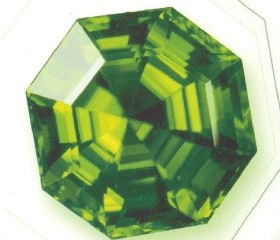
Peridot
– Peridot has been adored since early times, when the ancient Egyptians prized it more than 3500 years ago. Some jewelry historians are convinced that some, if not all, of the emeralds Cleopatra was famous for wearing were actually peridots mined from what is now known as St. John’s Island in the Red Sea, about 34 miles off the coast of Egypt. Peridot is a member of the olivine family of gemstones and is the birthstone for August. This beautiful lime-green gemstone depends largely on body mass for its concentration of color and, hence, its beauty. Unfortunately, larger stones have become so rare that the green hue for which this gem is most praised is seldom seen today. Much of today’s peridot comes from Arizona, however, stones rarely exceed 3 carats in size. Peridot is also found Australia, Brazil, China, Myanmar (Burma) and Pakistan.
Enhancements – Peridot is completely natural in color and clarity. There are no known commercial treatments being done today to enhance these beautiful apple green gemstones. The owner of a beautiful peridot will cherish the fact that their peridot is one of the few colored gemstones in today’s market that exhibits the exact color and clarity that mother nature produced, with its beauty brought to the surface strictly by the artistry of the cutter. Back to Top
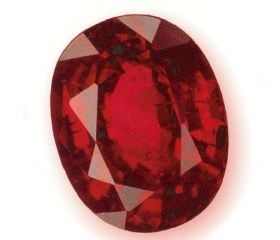
Ruby – Ruby, “the King of Gems” and birthstone for July, gets it’s name because of its red color and is derived from the Latin word Rubeus, meaning red. It was discovered around 1800 that Ruby, as well as sapphire, belonged to the same mineral group, or species, called corundum. Prior to that date, both red spinel and garnet were thought to be, or were referred to, as Ruby. In fact, many of the most prominent red gemstones in England’s Royal Jewels are magnificent red spinels which, for years, were thought have been rubies. The red color in Ruby is derived from chromium and historically, the most desirable ruby color is denoted by the term “pigeons blood”. The red color of Ruby will vary from deposit to deposit and it is, therefore, not possible to determine the source area of a Ruby based on its color. Ruby is mined throughout Southeast Asia and while the majority is found in Thailand and Myanmar (Burma), many exquisite gems also are found in Sri Lanka and Africa. The designation Burmese-ruby or Siam-ruby are trade names and refer more to color quality than to actual origin. Internal characteristics, or inclusions, are very common and while these inclusions are not necessarily indicative of lower quality, they may show the difference between natural and synthetic. Certain types of inclusions may also indicate the source area, or origin, of the gemstone.
Enhancements – As is the case with many colored gemstones, Rubies are routinely enhanced to improve their color and their clarity, the most notable being controlled heating. Many enhancement procedures are generally recognized and accepted throughout the jewelry industry and, in most cases, these enhancements are irreversible, permanent, and will produce a gemstone that is more beautiful. One should be leery, however, of enhancement techniques that are not permanent. If you intend to purchase any fine colored gemstone you should deal with a jeweler who is gemologically trained to explain the differences. Back to Top

Sapphire – Birthstone for the month of September, the name Sapphire comes from the Greek word “Sappheiros”, meaning blue. However, sapphires are formed in nature in a literal rainbow of colors, ranging from very light to very dark blue, bluish green, yellow, brown, pink, violet, slightly reddish orange, and a fabulous pinkish-orange that is referred to as “padparadscha”. The name padparadscha is derived from the Sinhalese for “lotus flower”. The mineral name for sapphire is Corundum and its pure red form it would be known as ruby. The finest sapphire color in the blue hues is a rich, velvety, cornflower blue known as “Kashmir”, which references the area of India where these precious gemstones were once mined. Most current production comes from Sri Lanka, Burma, Thailand, Australia, Africa and Montana. Sapphire will sometimes occur in nature in such a way whereby numerous needle-like inclusions within the gemstone are oriented in just the right angles within the stone, to produce a phenomenon that is called “asterism”. As such a six-pointed star will appear to float just beneath the surface of the gemstone when subjected to an incandescent light source. These gemstones will always range from translucent to opaque and they depend on the cutters art to fashion them into a polished, domed shape known as “cabochon”.
Enhancements – As is the case with many colored gemstones, sapphires are routinely enhanced to improve their color and their clarity, the most notable being controlled heating. Many enhancement procedures are generally recognized and accepted throughout the jewelry industry and, in most cases, these enhancements are irreversible, permanent, and will produce a gemstone that is more beautiful. One should be leery, however, of enhancement techniques that are not permanent. If you intend to purchase any fine colored gemstone you should deal with a jeweler who is gemologically trained to explain the differences. Back to Top
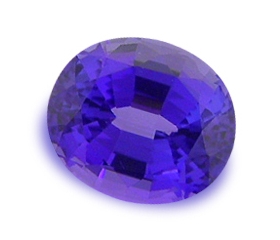
Tanzanite – At its breathtaking best, tanzanite will look amazingly like Kashmir sapphire, exhibiting the rich, royal velvety blue hue that these gemstones are prized for, and at a fraction of the price. This exquisite gemstone is renowned for the wonderful combination of purple and blue hues, observed in different intensities within the same gemstone. Tanzanite is a trichroic gemstone, meaning that it gives off three different colors when viewed in different directions, or along the optic axis. The dominant colors being blue and violet will cause tanzanite to appear violet when exposed to incandescent light and blue when exposed to fluorescent light. The third less dominant color is reddish brown or bronze, which is rarely visible to the naked eye. Tanzanite is a form of zoisite, which was named tanzanite due to its original discovery in Tanzania in 1967 and, to date, it is not found in any other place in the world. The introduction and popularity of the gemstone can be attributed to Tiffany and Company, who exclusively marketed the gemstone in the late 1960’s and early 1970’s. The American Gem Society has designated tanzanite as an option for the traditional December birthstones blue zircon and turquoise. Tanzanite is one of the most popular blue gemstones available today and while it has the beauty, rarity and durability to rival most colored gemstones, your tanzanite needs slightly more care and attention than due other harder gemstones, such as sapphire.
Enhancements – As mentioned above, tanzanite is part of the zoisite mineral species. In its natural form, tanzanite occurs as a brownish gemstone that is altered by heat to bring out its inherent rich blue and violet colors. Back to Top
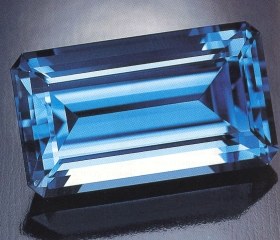
Topaz – The name topaz was probably derived from the ancient island of Topazios in the Red Sea. In ancient times all yellow, brown, and sometimes green gemstones were called “topaz”. Even through modern times, the brownish gemstone commonly referred to as Smokey Topaz is not topaz at all. Thanks to the adoption of Federal Trade laws, which have been successful in eliminating most of the misrepresentation of colored gemstones, the proper gem variety name, Smokey Quartz, is now used to describe these gems. The quartz variety citrine and yellow heat-treated amethyst have at times been falsely called “golden topaz” in the jewelry trade, which lead to real topaz being referred to as “precious topaz”. Commonly, one of the orangey or golden colors of topaz is worn as the traditional birthstone for November. Topaz, however, can be found in a rich rainbow of colors with the most valuable being “Imperial” topaz and pink topaz. Imperial topaz derived its name after the Russian Czars of the 1800’s, and has a magnificent orange body color, with pinkish-red undertones. In addition to these two, topaz can be found naturally in yellow, reddish-brown, light blue, pinky-red, pale green and colorless. Due the abundance of blue topaz, along with its captivating beauty and low price, it has become an ideal replacement option for aquamarine as the birthstone for March.
Enhancements – Most topaz is commonly subjected to enhancement by heat and/or radiation as a normal part of the fashioning process to improve its color. Irradiation is used sometimes to change colorless topaz to a brown or brownish green as a first step in producing treated blue topaz. The prevalence is common, is very stable and is virtually undetectable. Back to Top
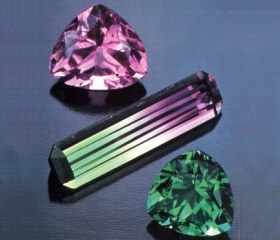
Tourmaline – Tourmaline, like garnet and sapphire, occurs in almost every color of the rainbow from soft pastel tones to bold and brilliant colors that excite the senses. The people of ancient Ceylon referred to these beautiful gems as “turmali”, the Sinhalese word for many colors. Varying vibrant hues within the tourmaline group are such that they command a name that separates them from the more common hues. The vivid reds and hot pinks are known as Rubellite, vibrant greens that crystallized containing the chemical chromium and are called Chrome Tourmaline, and the violetish to greenish blues are referred to as Indicolite. The pink variety is often used as the birthstone for October. Not only does tourmaline occur in such a spectacular range of color, some of these colors occur in a single gemstone and are called “bi-color” or “parti-colored” tourmalines. In fact, one color combination known as “watermelon” tourmaline, occurs with a pink center and green perimeter. Tourmaline is mined in many areas of the world including Brazil, Afghanistan, East Africa and the United States.
Enhancements – Color enhancement of tourmalines is very common. Dark blue, blue green, and green tourmalines are often heated and/or irradiated to improve their color. Heat and irradiation color enhancement of tourmaline is permanent. Back to Top

Turquoise
– December’s primary birthstone. Turquoise is considered by some to be a symbol of good fortune and success, believed to bring prosperity to its wearer. It’s name is believed to originate from the French phrase “pierre turquoise” meaning “Turkish stone” because turquoise was brought to Europe by Venetian merchants who first acquired it in Turkish bazaars. It is also considered by some as a love charm. When received as a gift, the turquoise symbolizes a pledge of affection. Shakespeare used this lore in “The Merchant of Venice”. In it, Leah gave a turquoise ring to Shylock when he was a bachelor, hoping it would win his affections so he would ask her to marry him. In Russia, the turquoise is popularly used in wedding rings. In the language of chemists and geologists, turquoise is known as “copper aluminum phosphate”. Turquoise is often found in weathered igneous rock that contains copper minerals, where it crystallizes in veins and nodules. The gemstone usually develops in rock near water tables, located in semiarid and arid environments. The chemicals in turquoise come from adjacent rock, leached out by rain and groundwater. Turquoise is a relatively soft gemstone, and can be easily scratched and broken. This porous opaque stone is easily discolored by oil and pigments, and changes color when it loses some of its water content. A sky blue shade in turquoise is due to the presence of copper, while iron gives it a greener tone. Ochre and brown-black veins in the stone occur during the formation of turquoise, caused by inclusions from nearby rock fragments or from oxide staining. The most valued variety of turquoise is an intense sky blue color, like the color of a robin’s egg. Hard, relatively non-porous compact stones have the best appearance because the stone can be finely polished.
Enhancements – Pale and chalky varieties are sometimes impregnated with oil, paraffin, liquid plastic and glycerin to give it a good polish. Back to Top
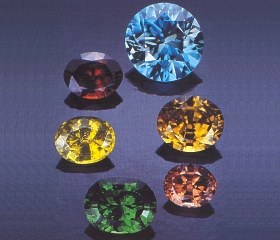
Zircon – The alternate birthstone for December is the zircon. Its name is probably derived from the Arabic words “zar” and “gun”, meaning “gold” and “color”. The gemstone is found in a wide range of colors, and possess great brilliance, fire and clarity. Zircon, in its unchanged natural form appears colorless to pale yellow, or green. These colors are caused by minute quantities of thorium and uranium that replaces zircon in the crystal structure. But over the vast spans of geologic time, other forces work within the zirconium silicate crystals. The uranium and thorium inclusions emit radiation that alters the original crystal structure. A glass-like material is formed, with colors of red to brown, orange and yellow. The mineral zircon, known as zirconium silicate, is commonly found as a minor constituent in igneous rock such as granites and some kinds of metamorphic rock. Gem quality zircon stones are usually rare. These gemstones are formed mainly in pegmatites (coarse-grained igneous rock) and in fissures. But due to weathering of the gem-bearing rocks, most zircons are found in alluvial and beach deposits. A new blue color for zircon, called “starlight blue,” was created by heating golden brown or yellow zircon in the 1920s. The most prized zircon is the red gemstone, which is rare. The pure intense blue and sky blue varieties are also highly valued, while the colorless, orange, brown and yellow stones are less expensive. Many zircons on the market are heat treated, and sold as blue, golden brown or colorless stones. Colorless zircons are the best imitators of diamonds, in appearance only, with a brilliant fire that is almost as dazzling as the real thing. However, the resemblance is superficial. Zircon is a brittle stone, easily broken with a well-placed knock, due to internal stresses in the crystal caused by radiation damage and heat treatment. But despite its frail disposition, the stone is still highly valued because of its stunning beauty. Back to Top
Synthetics and Gemstone Enhancements
Synthetics – Before purchasing any fine colored gemstone there are things you should know besides just the weight, the beauty, and the price that you are going to pay. So that you do not make a costly mistake, it will be worth your while to work with one of our experts to help you make your decision. If a colored gemstone is desirable and has significant value, you can be sure that there is a synthetic counterpart to that gemstone available in the marketplace. Synthetic does not mean just a look-alike gemstone, although there are those as well. Synthetic means that the laboratory-grown gem is a chemical and crystalline duplicate of the natural gemstone, and usually it takes a gemologist, with the aide of special gemological equipment to determine the difference. Synthetics have natural looking inclusions, which resemble those found in their natural counterpart.
Enhancements – Over many centuries man has experimented with, and perfected, countless methods to improve upon the natural properties of gemstones. These techniques are known as “enhancements”. These methods reflect upon man’s desire to draw upon the truest and purest color and brilliance that a gemstone has to offer. The art of cutting a gemstone is man’s most basic enhancement method necessary to fully display the beauty of a fine gem. However, there are many fascinating methods by which man has demonstrated his ability to draw maximum color, luster, clarity, and brilliance from nature’s most precious gifts. There are many recognized and accepted enhancement techniques and there are many that are not. A basic understanding of these enhancement techniques will add to your appreciation of the beauty, durability and value of the colored gemstone you already own, or are planning to purchase now or in the future. Back to Top

